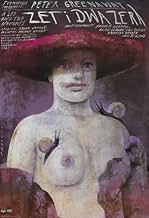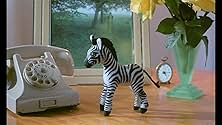IMDb रेटिंग
7.2/10
7.9 हज़ार
आपकी रेटिंग
अपनी भाषा में प्लॉट जोड़ेंTwin zoologists lose their wives in a car accident and become obsessed with decomposing animals.Twin zoologists lose their wives in a car accident and become obsessed with decomposing animals.Twin zoologists lose their wives in a car accident and become obsessed with decomposing animals.
फ़ीचर्ड समीक्षाएं
Greenaway's obsessions with lists, wordplay, coincidence, sexuality, the surreal, and the explicit (not to mention the "conventionally used" ones like men and women, birth and eating and death, physiology (formal and psychological), and abstraction) come to a head in this film. A bizarre mileau of fancy digressions and focused narrativity create a film which is perhaps too obtuse for first time viewers but is, as far as I'm concerned, the best way to initiate oneself into the "world" of Greenaway.
I knew how strange and unusual Greenaway could be but Zed, I believe could take the cake :). I am not sure what it is all about but I still enjoy the triumvirate Greenaway - Sasha Verny- Michael Nyman. Some ideas and images Greenaway will use in the later "8 1/2 women" and "The Cook, The Thief, His Wife, and Her Lover" - especially, the soundtrack. "Dead Ringers" and "Mon oncle d'Amérique" (two beautiful weirdnesses themselves) also come to mind while watching Greenaway's elegant tale of decomposing which is also his meditations about life, death and grief. As in earlier "The Draughtsman's Contract (1982), Greenaway explores the relationship between the close relatives - the twin brothers are in the center of "A Zed & two Noughts". The movie is also a modern retelling of an ancient myth about Leda and Zeus who took the form of a swan and slept with Leda on the same night as her husband, King Tyndareus. Leda bore Helen and Polydeuces, children of Zeus while at the same time bearing Castor and Clytemnestra, children of her husband Tyndareus, the King of Sparta.
Greenaway considers that 90% of his films one way or another refers to paintings. "A Zed & two Noughts" refers openly and with great admiration to the paintings of Johannes Vermeer van Delft.
"A Zed & two Noughts" is not easy film to watch, its characters are not sympathetic, it lacks warmth and sentimentality but as always in Greenaway's films, it is a feast for eyes, ears, and for brain.
7.5/10
Greenaway considers that 90% of his films one way or another refers to paintings. "A Zed & two Noughts" refers openly and with great admiration to the paintings of Johannes Vermeer van Delft.
"A Zed & two Noughts" is not easy film to watch, its characters are not sympathetic, it lacks warmth and sentimentality but as always in Greenaway's films, it is a feast for eyes, ears, and for brain.
7.5/10
This fine film is written in an intelligent, multilayered way of such a degree and quality as I have only seen in top-notch theatre. Greenaway delivers a dark but intoxicating tale of decay, evolution and the crucial importance of symmetry.
The themes of this film emerge not only through Greenaway's script, but also through the images produced by his tight, clear directing. The choice of images and ability to linger on single shots suggests a creative mind as focused and obsessed as the characters he portrays.
As with many of Greenaway's works, this certainly isn't a film for anyone wanting a cheap thrill and easy satisfaction. Its particularly dark humour and images of accelerated decay and death are more likely to please those who prefer to view film as a medium of art than those seeking mere entertainment.
It is a very long time since a film has impressed me quite as much as this.
The themes of this film emerge not only through Greenaway's script, but also through the images produced by his tight, clear directing. The choice of images and ability to linger on single shots suggests a creative mind as focused and obsessed as the characters he portrays.
As with many of Greenaway's works, this certainly isn't a film for anyone wanting a cheap thrill and easy satisfaction. Its particularly dark humour and images of accelerated decay and death are more likely to please those who prefer to view film as a medium of art than those seeking mere entertainment.
It is a very long time since a film has impressed me quite as much as this.
A Zed and Two Noughts (or Zoo) is Greenaway's best film. Made during the transition between his early experimental short films and his later more narrative (and more celebrated) ones, his free flowing structure is at its best here, fresh, witty and cerebral (some would also say pedantic). In later films, one has the feeling that Greenaway has try to go back to the style set by Zoo, but the results (like in 8 1/2 women) are almost unwatchable. The plot: two biologists twins working in a zoo, specialized in studying the putrefaction of animals, lose their wives in a car accident. They hook up with a strange woman who lost her leg in that accident. Meanwhile, there are references to Vermeer throughout (what does this has to do with zoology, only Greenaway knows), speeded up shots of real rotting animals, Michael Nyman's hypnotic score, and also a girl who learns the alphabet through giant letters that are linked with live animals (for example, z is for zebra, as in a children's book). Deliberately non naturalistic, Greenaway makes from this strange melange a very compelling movie, though undoubtedly very hard to take for some.
All you need to make cinema is a point of view (and of course the view to which it points). Or a frame of reference and the reference which it frames. In Greenaway all these exist together, knowingly, as forms within forms.
A story of twins looking to overcome grief by studying the decay of death is the reference here. Zebras, lizards, swans, we see the empty shells of body decay before the camera. Kept under the scrutiny of our gaze in life, inside cages, they remain under it once dead. At what point do all these symmetries which conjoined together make up the miracle of life stop being the sum of their parts, and by which process; how much of these parts that we understand as the self can be taken out before the self is no longer recognized; and the symmetry once broken, what mystery renews it.
These obscure ruminations are framed against the question of existence, which implies god and pattern. How come that something so systemised, so perfectly designed and evolved from nothing, from amoeba and algea, can come to pass by the whim of chance? Having taken millions of years for creation to unravel its complexity, why does it take a second to destroy it? Which is to ask, at what point does the system, which in hindsight appears ordained and patterned, become random and meaningless.
Various eccentricities are enacted in this process, all pointing to some kind of symbolic nakedness.
When the legless woman gives birth to new life, twins again, the old twins, the blueprint for them, must step aside. The film ends with an poignant thought. Having carefully staged their own death so that the decay that follows may be captured on film, we see how nature intrudes upon this scene and foils the effort.
An atheist himself, Greenaway here gives us a pessimism that cuts deep; no consciousness survives this.
A story of twins looking to overcome grief by studying the decay of death is the reference here. Zebras, lizards, swans, we see the empty shells of body decay before the camera. Kept under the scrutiny of our gaze in life, inside cages, they remain under it once dead. At what point do all these symmetries which conjoined together make up the miracle of life stop being the sum of their parts, and by which process; how much of these parts that we understand as the self can be taken out before the self is no longer recognized; and the symmetry once broken, what mystery renews it.
These obscure ruminations are framed against the question of existence, which implies god and pattern. How come that something so systemised, so perfectly designed and evolved from nothing, from amoeba and algea, can come to pass by the whim of chance? Having taken millions of years for creation to unravel its complexity, why does it take a second to destroy it? Which is to ask, at what point does the system, which in hindsight appears ordained and patterned, become random and meaningless.
Various eccentricities are enacted in this process, all pointing to some kind of symbolic nakedness.
When the legless woman gives birth to new life, twins again, the old twins, the blueprint for them, must step aside. The film ends with an poignant thought. Having carefully staged their own death so that the decay that follows may be captured on film, we see how nature intrudes upon this scene and foils the effort.
An atheist himself, Greenaway here gives us a pessimism that cuts deep; no consciousness survives this.
क्या आपको पता है
- ट्रिवियाThis film was Peter Greenaway's first collaboration with cinematographer Sacha Vierny, who went on to shoot virtually all of Greenaway's work in the 1980s and 1990s, until Vierny's death in 2001. Greenaway referred to Vierny as his "most important collaborator".
- भाव
Alba Bewick: In the land of the legless the one-legged woman is queen.
- कनेक्शनFeatured in Peter Greenaway (1992)
- साउंडट्रैकThe Teddy Bears' Picnic
Music by John W. Bratton
Lyrics by Jimmy Kennedy
Performed by The BBC Dance Orchestra
Directed by Henry Hall
Courtesy of EMI MUSIC PUBLISHING LTD and EMI RECORDS LTD
Also sung by Venus De Milo (Frances Barber)
टॉप पसंद
रेटिंग देने के लिए साइन-इन करें और वैयक्तिकृत सुझावों के लिए वॉचलिस्ट करें
- How long is A Zed & Two Noughts?Alexa द्वारा संचालित
विवरण
- रिलीज़ की तारीख़
- कंट्री ऑफ़ ओरिजिन
- भाषाएं
- इस रूप में भी जाना जाता है
- A Zed and Two Noughts
- फ़िल्माने की जगहें
- उत्पादन कंपनियां
- IMDbPro पर और कंपनी क्रेडिट देखें
इस पेज में योगदान दें
किसी बदलाव का सुझाव दें या अनुपलब्ध कॉन्टेंट जोड़ें






























